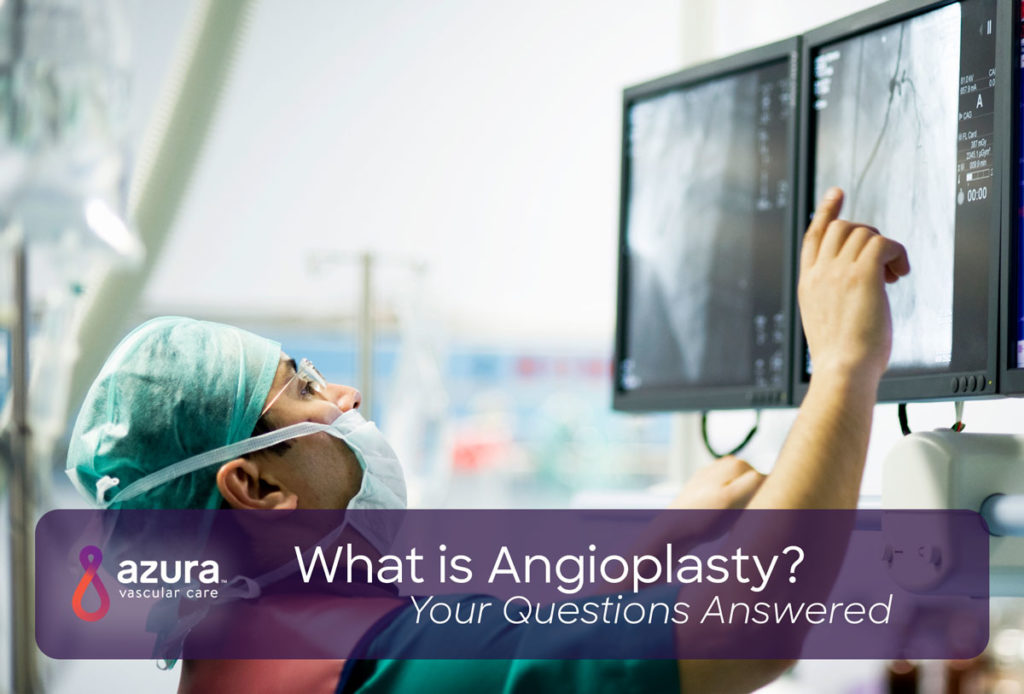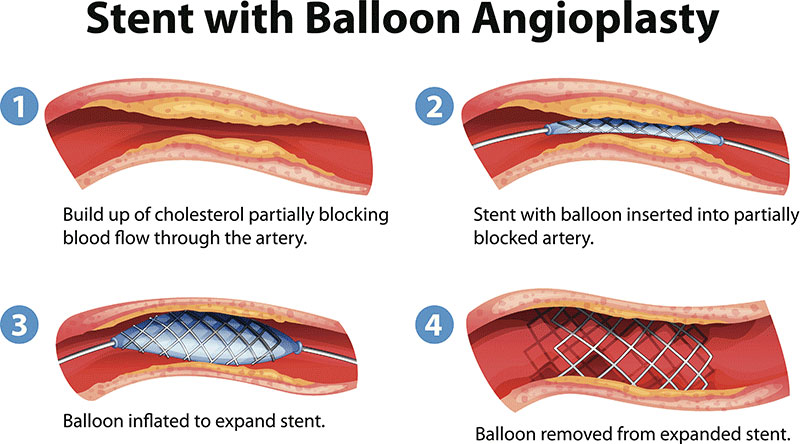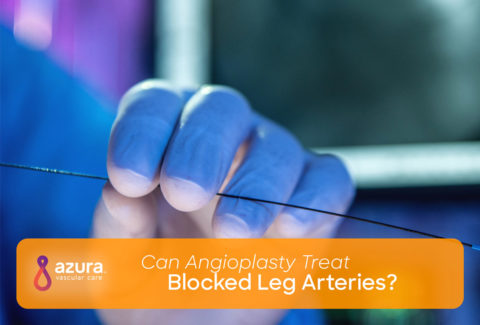
If your arteries have become blocked or narrowed from a build-up of cholesterol, cells, or other substances, your doctor may suggest a procedure called angioplasty. You may be wondering what is angioplasty? Are there different types of angioplasty? How is it different from surgery? What are the risks and benefits?
This article will help serve as your guide to understanding angioplasty, the different types of angioplasty, and things you need to know before and after the angioplasty procedure.
What is Angioplasty and Why Do I Need It?
An angioplasty is a type of minimally invasive procedure used to unblock arteries and restore normal blood flow to particular organs or tissues within the body. (ii)
Your arteries are the blood vessels responsible for delivering nutrient-rich, oxygenated blood to your organs and tissues. Arteries become narrowed or blocked when there is a build-up of fat, cholesterol, calcium, and other substances found within the blood. This build-up is known as plaque, and over time hardens and narrows your arteries, limiting the flow of oxygen-rich blood. (i)
Depending on where this build-up occurs within the body, narrowed or blocked arteries that are left untreated can cause tissue death, heart attack, stroke, and even death. It is important to talk to your doctor early about any unusual symptoms you might be experiencing as well as your treatment options. (ii, iii)
What Happens During an Angioplasty Procedure?
Angioplasty is not considered major surgery. These procedures are most often performed under conscious or moderate sedation in a cardiovascular catheterization laboratory, also known as a ‘cath lab.’
The procedure is done by threading a thin tube, called a catheter, through a small puncture in a leg or arm artery. The catheter is then passed through the artery under imaging guidance until it reaches the area of narrowing or blockage. Once in properly positioned, a small balloon located at the end of the catheter is inflated, pushing the plaque up against the walls of your artery and opening up the vessel to restore flow. It’s possible that your physician may inflate and deflate the balloon several times to stretch the artery. After the narrowed or blocked area is successfully widened, the balloon is deflated and removed.

In some cases, a collapsible stent is mounted over the deflated balloon before insertion. When the balloon is inflated, it simultaneously pushes the plaque and opens the stent against the artery wall. The stent remains in this position permanently and helps keep the artery open. The balloon and wire are then removed.
The length of the procedure varies by case but typically lasts 30-60 minutes. (iii, v, vi)
What are the Different Types of Angioplasty?
There are a few different instances where angioplasty can be used to unblock blood vessels. You may be most familiar with a type of angioplasty procedure referred to as cardiac angioplasty, but angioplasty is also utilized in other parts of the body as well.
What is Cardiac Angioplasty?
Cardiac angioplasty is where a cardiologist or surgeon works to unblock one or multiple arteries that are supplying blood to the heart muscle. The blockage of one or more arteries supplying the heart is commonly referred to as coronary artery disease. (iii)
Patients needing cardiac angioplasty may be having symptoms of pain and discomfort in their chest or shortness of breath.
What is Peripheral Angioplasty?
Peripheral angioplasty refers to the procedure of unblocking arteries in your extremities, i.e., your arms and legs. Patients needing peripheral angioplasty may be experiencing symptoms of pain, cramping, fatigue, tingling, skin discoloration, or numbness in their arms or legs.
One common type of peripheral angioplasty refers to the treatment of peripheral arterial disease (PAD) in the legs. PAD is a circulatory problem in which a person doesn’t receive enough blood flow to their legs in order to keep up with their body’s needs due to narrowed or blocked arteries.
RELATED: Learn more about PAD and angioplasty for PAD here
Peripheral angioplasty can also be used if you have an AV fistula or an AV graft and are having problems with blood flow during hemodialysis. (iv)
If you are having difficulty dialyzing or are unable to dialyze altogether, your doctor may order imaging tests, such as an ultrasound or angiogram, to assess your vessels for any narrowing or blockages that may be contributing to dialysis problems. If a narrowing or blockage is identified, angioplasty may be utilized to re-open those vessels, in order to be able to keep using your AV fistula or graft for dialysis.
What are the Benefits of Angioplasty?
Angioplasty is minimally invasive compared to open surgery and is relatively low-risk and low-cost.
Because these procedures are performed using conscious or moderate sedation rather than general anesthetic, there is typically no need for an extended stay in the hospital.
Additionally, no surgical incision is needed. Because the procedure is performed through a small puncture in the skins, there is no need for stitching or sutures. You will also be able to resume your normal activities shortly afterward. (v)
What are the Risks of Angioplasty?
Major complications after angioplasty are rare but should be explained in entirety by your physician. (v)
Inserting the catheter utilized in angioplasty may injure the artery. There is also a minimal risk of blood clots, and blockages can recur over time.
A patient may also experience heavy bleeding at the catheter insertion site and may require additional imaging or medical attention if it worsens.
What Are the Limitations of Angioplasty?
Sometimes, the catheter used in angioplasty cannot be successfully passed through the artery due to significant narrowing or blockage within the artery in order to inflate the balloon and push the plaque against the artery wall.
When this occurs, patients may feel only minimal relief of their symptoms, or none at all. In these cases, patients may be referred on for surgery in order to address their blockages. (v)
What Can I Expect After Angioplasty?
Recovery from angioplasty is typically brief, where many patients are able to go home approximately 12 to 24 hours after the catheter is removed. Work can usually be resumed a few days to a week after the procedure.
It is common to experience bruising, discoloration, or soreness at the site where the catheter was inserted. You may also notice a small bump which should not grow in size. Your physician or nurse will give clear instructions on signs and symptoms to be aware of after the procedure.
How We Can Help You
While angioplasty is a minimally-invasive, outpatient procedure, we understand that it can feel like a big decision and we are always happy to address any concerns or questions you might have. At Azura Vascular Care, our physicians have the training and resources to perform minimally invasive procedures for various arterial diseases that can effectively and safely be treated in an outpatient setting. If you are ready to speak to one of our specialists or want more information about angioplasty, you can contact us at 844.832.8346 or find a center near you.
Sources:
(i) National Heart, Lung, and Blood Institute. (n.d.). Atherosclerosis. Retrieved July 15, 2019, from https://www.nhlbi.nih.gov/health-topics/atherosclerosis.
(ii) American Heart Association. (2015). What Is Coronary Angioplasty? Retrieved July 15, 2019, from https://www.heart.org/-/media/data-import/downloadables/pe-abh-what-is-coronary-angioplasty-ucm_300437.pdf.
(iii) Mayo Clinic. (n.d.). Coronary angioplasty and stents. Retrieved July 15, 2019, from https://www.mayoclinic.org/tests-procedures/coronary-angioplasty/about/pac-20384761.
(iv) Radiology Info. (January 23, 2019). Dialysis and Fistula/Graft Declotting and Interventions. Retrieved July 15, 2019, from https://www.radiologyinfo.org/en/info.cfm?pg=dialysisfistulagraft.
(v) Radiology Info. (February 26, 2019). Angioplasty and Vascular Stenting. Retrieved July 15, 2019, from https://www.radiologyinfo.org/en/info.cfm?pg=angioplasty.
(vi) Bojakowski, K., Góra, R., Szewczyk, D., & Andziak, P. (2013). Ultrasound-guided angioplasty of dialysis fistula – technique description. Polish journal of radiology, 78(4), 56–61. doi:10.12659/PJR.889524.



